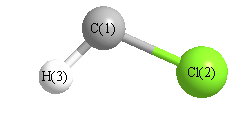Jump to
S2C1
Energy calculated at CCSD/aug-cc-pVDZ
| | hartrees |
|---|
| Energy at 0K | -498.126267 |
| Energy at 298.15K | -498.126129 |
| HF Energy | -497.832158 |
| Nuclear repulsion energy | 38.134364 |
The energy at 298.15K was derived from the energy at 0K
and an integrated heat capacity that used the calculated vibrational frequencies.
Geometric Data calculated at CCSD/aug-cc-pVDZ
Point Group is Cs
Cartesians (Å)
| Atom |
x (Å) |
y (Å) |
z (Å) |
|---|
| C1 |
0.046 |
1.212 |
0.000 |
| Cl2 |
0.046 |
-0.512 |
0.000 |
| H3 |
-1.055 |
1.438 |
0.000 |
Atom - Atom Distances (Å)
| |
C1 |
Cl2 |
H3 |
| C1 | | 1.7248 | 1.1243 |
Cl2 | 1.7248 | | 2.2403 | H3 | 1.1243 | 2.2403 | |
 More geometry information
More geometry information
Calculated Bond Angles
| atom1 |
atom2 |
atom3 |
angle |
|
atom1 |
atom2 |
atom3 |
angle |
| Cl2 |
C1 |
H3 |
101.599 |
|
Electronic energy levels
Charges, Dipole, Quadrupole and Polarizability
Jump to
S1C1
Energy calculated at CCSD/aug-cc-pVDZ
| | hartrees |
|---|
| Energy at 0K | -498.120125 |
| Energy at 298.15K | -498.119975 |
| HF Energy | -497.855222 |
| Nuclear repulsion energy | 38.405028 |
The energy at 298.15K was derived from the energy at 0K
and an integrated heat capacity that used the calculated vibrational frequencies.
Geometric Data calculated at CCSD/aug-cc-pVDZ
Point Group is Cs
Cartesians (Å)
| Atom |
x (Å) |
y (Å) |
z (Å) |
|---|
| C1 |
0.037 |
1.172 |
0.000 |
| Cl2 |
0.037 |
-0.520 |
0.000 |
| H3 |
-0.852 |
1.813 |
0.000 |
Atom - Atom Distances (Å)
| |
C1 |
Cl2 |
H3 |
| C1 | | 1.6917 | 1.0963 |
Cl2 | 1.6917 | | 2.4968 | H3 | 1.0963 | 2.4968 | |
 More geometry information
More geometry information
Calculated Bond Angles
| atom1 |
atom2 |
atom3 |
angle |
|
atom1 |
atom2 |
atom3 |
angle |
| Cl2 |
C1 |
H3 |
125.813 |
|
Electronic energy levels
Charges, Dipole, Quadrupole and Polarizability
